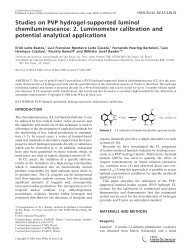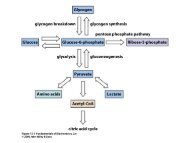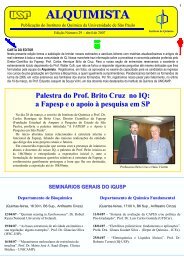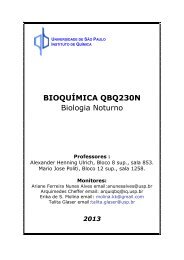The development of strategies for terpenoid structure determination
The development of strategies for terpenoid structure determination
The development of strategies for terpenoid structure determination
You also want an ePaper? Increase the reach of your titles
YUMPU automatically turns print PDFs into web optimized ePapers that Google loves.
double bond <strong>of</strong> lanosterol 48 played an important role in the<strong>structure</strong> <strong>determination</strong> <strong>of</strong> this tri<strong>terpenoid</strong>.9 Sesquiterpenes with medium-sized rings<strong>The</strong> classical methods <strong>of</strong> <strong>structure</strong> <strong>determination</strong>, in whichdehydrogenation to aromatic hydrocarbons played a major role,were restricted to particular skeleta such as those based on anaphthalene or an azulene. <strong>The</strong> <strong>structure</strong> <strong>of</strong> the nine-memberedring <strong>of</strong> caryophyllene 49 was a matter <strong>of</strong> doubt <strong>for</strong> many years.Although caryophyllene had been known as a constituent <strong>of</strong>oil <strong>of</strong> cloves since 1834 and a crystalline nitrosite had beendescribed 66 in 1892, its <strong>structure</strong> was not finally establisheduntil the 1950’s. Oxidative degradation <strong>of</strong> caryophyllene 49af<strong>for</strong>ded three homologous cyclobutanedicarboxylic acids(e.g. 50) which were synthesized in 1936 67 thus establishing thepresence <strong>of</strong> the four membered ring. A suggestion 68 that caryophyllenecontained a nine-membered ring was based on theinfrared absorption <strong>of</strong> a nor-ketone derived from caryophylleneoxide. Definitive evidence <strong>for</strong> the <strong>structure</strong> <strong>of</strong> caryophyllenecame from the base-catalysed cyclization <strong>of</strong> this nor-ketone(kobusone 51) to a tricyclic hydroxyketone and its subsequentdegradation. 69 This was accompanied by studies on the acidcatalysedcyclization products <strong>of</strong> caryophyllene and caryophylleneoxide which gave compounds possessing the caryolane andclovane skeleta. An X-ray crystal <strong>structure</strong> <strong>of</strong> one <strong>of</strong> the cyclizationproducts, caryophanyl chloride, provided confirmatoryevidence <strong>for</strong> the <strong>structure</strong> <strong>of</strong> caryophyllene. 70ten-membered rings <strong>of</strong> the sesquiterpene lactones readily lentthemselves to this type <strong>of</strong> NMR study in which the contiguousrelationship <strong>of</strong> proton–proton spin systems could be unravelled.Hence many <strong>of</strong> their <strong>structure</strong>s were established in the1960’s.10 <strong>The</strong> impact <strong>of</strong> IR spectroscopy<strong>The</strong> elucidation <strong>of</strong> the <strong>structure</strong> <strong>of</strong> terpenes in the 1950’s madeuse <strong>of</strong> classical dehydrogenation and oxidative degradationaccompanied by interpretation <strong>of</strong> the IR spectra. <strong>The</strong> correlationbetween ring size and the frequency <strong>of</strong> the carbonylabsorption in the infrared spectrum played an important rolein the identification <strong>of</strong> the ring size <strong>of</strong> ketones, lactones, andcyclic anhydrides. 72 This is exemplified by the characterization<strong>of</strong> the functional groups <strong>of</strong> the plant hormone, gibberellicacid 54, 73 and by the studies on the di<strong>terpenoid</strong> fungal metaboliterosenonolactone 55 in which the presence <strong>of</strong> the γ-lactone(ν max 1786 cm 1 ) and the cyclohexanone (ν max 1724 cm 1 ) wereestablished 74 by infrared spectroscopy.<strong>The</strong> correlation between ring size and absorption was particularlyuseful in establishing the size <strong>of</strong> bridged rings. Thisis exemplified by structural work on α-cedrene 56 in whichthe size <strong>of</strong> the ring containing the double bond was in doubt.Oxidative cleavage <strong>of</strong> this ring gave a norcedrene dicarboxylicacid 57. This diacid was converted to an anhydride which hadthe infrared characteristics <strong>of</strong> a glutaric rather than a succinicanhydride. 75 This infrared study complemented the notalways reliable Blanc method <strong>of</strong> determining the ring size <strong>of</strong>anhydrides in which pyrolysis <strong>of</strong> glutaric anhydrides gavecyclopentanones whilst succinic anhydrides did not react. <strong>The</strong>infrared absorption <strong>of</strong> the ring D ketones derived from thetetracyclic di<strong>terpenoid</strong>s <strong>of</strong> the gibberellin and kaurene seriescharacterized them as cyclopentanones. 73,76<strong>The</strong> propensity <strong>of</strong> many medium-sized rings to undergocyclization reactions provided the basis <strong>for</strong> <strong>strategies</strong> <strong>for</strong> theelucidation <strong>of</strong> the <strong>structure</strong>s <strong>of</strong> other families <strong>of</strong> <strong>terpenoid</strong>natural product. This is exemplified by the ten-memberedring <strong>of</strong> the germacranolide lactones such as pyrethrosin. 71 Acidcatalysed cyclization <strong>of</strong> pyrethrosin 52 gave a decalin 53 whichwas correlated with ψ-santonin. However it was not until theadvent <strong>of</strong> NMR spectroscopy that many other <strong>structure</strong>s <strong>of</strong>this type were elucidated.Whereas the existence <strong>of</strong> quaternary centres at ringjunctions provided a stabilizing feature as far as chemicaldegradation was concerned leading to the identification <strong>of</strong>alkylcyclopentane and cyclohexane fragments, the presence<strong>of</strong> a quaternary methyl group <strong>of</strong>ten provided a block toestablishing connectivities between protons by NMR spindecoupling studies. On the other hand the highly functionalized11 <strong>The</strong> <strong>determination</strong> <strong>of</strong> relative stereochemistry<strong>The</strong> problems associated with establishing the relative stereochemistry<strong>of</strong> the <strong>terpenoid</strong>s can be divided into those relating tothe stereochemistry <strong>of</strong> the substituents and those associatedwith the stereochemistry <strong>of</strong> the ring junctions. Many <strong>of</strong> theclassical pre-spectroscopic <strong>strategies</strong> yielded results in the1940’s and 1950’s.<strong>The</strong> assignment <strong>of</strong> the stereochemistry <strong>of</strong> the menthols 58utilized 77 the comparative rates <strong>of</strong> their esterification withp-nitrobenzoyl chloride to determine the configuration <strong>of</strong> thealcohols at C-3. <strong>The</strong> two neomenthols were esterified moreslowly than either menthol or isomenthol. This was attributedto steric hindrance by the isopropyl group and hence this groupwas placed cis to the hydroxy in the neomenthols. <strong>The</strong> muchslower rate <strong>of</strong> hydrolysis <strong>of</strong> methyl podocarpate 59 comparedto methyl dehydroabietate 60 was used 78 to reveal the greatersteric hindrance in the <strong>for</strong>mer arising from interactions with themethyl group at C-10. <strong>The</strong> ester is an axial substituent in methylpodocarpate.Nat. Prod. Rep., 2001, 18, 607–617 611
<strong>The</strong> trans A/B stereochemistry <strong>of</strong> the abietic and pimaricacids was established 46 by examining the pK values <strong>of</strong> thecarboxylic acids 37 derived by oxidative degradation. <strong>The</strong>seresults were then extended to the triterpenes. <strong>The</strong> results <strong>of</strong>stereochemical studies in the terpene and steroid series providedmany <strong>of</strong> the examples on which the theories <strong>of</strong> the con<strong>for</strong>mationalanalysis <strong>of</strong> reactions were based.<strong>The</strong> con<strong>for</strong>mational stability <strong>of</strong> trans fused α-decalones wasused to establish the B/C trans configuration in the pentacyclictriterpenes 79 and to establish the trans A/B fusion in thedi<strong>terpenoid</strong>s such as marrubiin 61. 80 An interesting summary<strong>of</strong> the application <strong>of</strong> these reactions to the stereochemistry <strong>of</strong>the eudesmane group <strong>of</strong> sesquiterpenes appeared in 1960. 81<strong>The</strong> strategy <strong>of</strong> using cyclization reactions such as lactonizationreactions to establish the cis stereochemistry <strong>of</strong> the D/Ering junction in the pentacyclic triterpenes, in which the facile<strong>for</strong>mation <strong>of</strong> the lactone 62 could only be accommodated withcis ring junction, is an example. 79,82<strong>The</strong> elucidation <strong>of</strong> the cyclization reactions <strong>of</strong> santonin togive the bridged santonic acid 63 played an interesting rolein establishing the stereochemistry <strong>of</strong> santonin. 83 Howeverthe correct configuration at C-11 was eventually establishedby X-ray analyses <strong>of</strong> 2-bromo-α-santonin and 2-bromo-βsantonin.84which was related to ()-citronellal, established 88 the absolutestereochemistry <strong>of</strong> the steroids at C-20.<strong>The</strong> extension <strong>of</strong> the method <strong>of</strong> molecular rotation differences,which had been successfully applied to correlations <strong>of</strong>stereochemistry in the steroid series, to similar changes in thetriterpenes 89 and then to the sesqui- and diterpenes, 90 provideduseful correlations <strong>of</strong> absolute stereochemistry.13 Optical rotatory dispersion and circular dichroism<strong>The</strong> closely related methods <strong>of</strong> optical rotatory dispersion andcircular dichroism played an important role in establishingthe absolute stereochemistry <strong>of</strong> <strong>terpenoid</strong> natural products. 91Although some <strong>of</strong> the first observations <strong>of</strong> the change <strong>of</strong>optical rotation with wavelength were made with camphor, theprincipal applications to stereochemistry did not begin untilthe 1950’s with the work <strong>of</strong> Djerassi and Klyne. <strong>The</strong> octantrule, <strong>for</strong> predicting the sign <strong>of</strong> the Cotton effect in the ORDcurve <strong>of</strong> ketones in a chiral environment, was based on theposition <strong>of</strong> substituents adjacent to the ketone. 92 This <strong>development</strong>meant that it was possible to assign the absolute stereochemistryto a number <strong>of</strong> <strong>terpenoid</strong>s. A particular impact<strong>of</strong> these studies was the demonstration that a number <strong>of</strong>di<strong>terpenoid</strong>s belonged to the antipodal series, i.e. their absolutestereochemistry at the A/B ring junction was opposite to that <strong>of</strong>the steroids and other di<strong>terpenoid</strong>s such as abietic acid. Forexample the di<strong>terpenoid</strong> cafestol 65 was converted into theethylketone 66. 93 <strong>The</strong> ORD curve <strong>of</strong> this ketone was the mirrorimage <strong>of</strong> the curve from 4α-ethylcholestan-3-one and hence theabsolute stereochemistry <strong>of</strong> the A/B ring junction <strong>of</strong> cafestol isopposite to that <strong>of</strong> the steroids. Studies on the ring D ketones<strong>of</strong> a number <strong>of</strong> di<strong>terpenoid</strong>s were important in establishingtheir absolute stereochemistry. 76,9412 <strong>The</strong> <strong>determination</strong> <strong>of</strong> absolute stereochemistryA number <strong>of</strong> monoterpenes were known to occur in both enantiomeric<strong>for</strong>ms. Optically active methylsuccinic and β-methyladipicacids had been obtained as degradation products andthese were correlated with D-()-glyceraldehyde. Other interrelationshipsbetween the mono<strong>terpenoid</strong>s provided usefulstereochemical correlations. 85 Hence when the absolute stereochemistry<strong>of</strong> sodium rubidium tartrate was established byX-ray crystallography and the correlation made with D-()-glyceraldehyde, 86 the absolute stereochemistry <strong>of</strong> many <strong>of</strong> themonoterpenes was established.Synthetic interrelationships between carvone and the sesquiterpenes<strong>of</strong> the eudesmane series and between eudesmol andthe steroid series led to a correlation <strong>of</strong> their absolute stereochemistry.87 An important degradation <strong>of</strong> cholest-14-en-3β-olto give a fragment 64 containing the steroid side chain and14 <strong>The</strong> absolute stereochemistry <strong>of</strong> <strong>terpenoid</strong> secondaryalcoholsA number <strong>of</strong> methods have been developed <strong>for</strong> establishing theabsolute stereochemistry <strong>of</strong> a secondary alcohol. Studies on theaddition <strong>of</strong> Grignard reagents to the α-keto-esters <strong>of</strong> opticallyactive <strong>terpenoid</strong> alcohols showed 95 that asymmetric inductioncould be used to establish the stereochemistry <strong>of</strong> a chiralalcohol. <strong>The</strong> chirality <strong>of</strong> the atrolactic acid that was <strong>for</strong>medreflected that <strong>of</strong> the original secondary alcohol. Horeau’smethod 96 was based on the kinetic resolution by the alcohol inits esterification by 2-phenylbutyric anhydride. <strong>The</strong> method isbased on using a racemic mixture <strong>of</strong> the anhydride. Oneenantiomer will react faster with the chiral secondary alcoholthan the other. <strong>The</strong> optical activity <strong>of</strong> the remaining 2-phenylbutyricacid will thus reflect the chirality <strong>of</strong> the secondaryalcohol.An NMR method based on derivatization with (R)- and (S)-α-methoxy-α-trifluoromethylphenylacetic acid (MTPA) hasbecome a popular strategy <strong>for</strong> establishing the absolute stereochemistry<strong>of</strong> <strong>terpenoid</strong> alcohols. 97 Although it was originallybased on an analysis <strong>of</strong> the 19 F NMR spectrum, a more reliable612 Nat. Prod. Rep., 2001, 18, 607–617
version uses the high field 1 H NMR spectrum. A correlationwas established between the absolute stereochemistry <strong>of</strong> <strong>terpenoid</strong>secondary alcohols and the ∆δ (δ S δ R ) values <strong>of</strong> adjacentprotons <strong>for</strong> the (R)- and (S)-MPTA esters. This correlation wassuccessfully applied in establishing the absolute stereochemistry<strong>of</strong> a number <strong>of</strong> marine <strong>terpenoid</strong>s <strong>of</strong> the cembranolide andxenicane series. 98In a few instances the absolute configuration <strong>of</strong> a <strong>terpenoid</strong>has been determined by X-ray crystallography <strong>of</strong> a heavy atomderivative, e.g. an ester or an amide containing a bromine atom.<strong>The</strong> assumption is <strong>of</strong>ten made that all <strong>of</strong> a group <strong>of</strong> terpenesthat occur in a particular plant belong to the same enantiomericseries. However there have been a number <strong>of</strong> reports where,<strong>for</strong> example, enantiomeric labdane diterpenes co-occur in thewood <strong>of</strong> Oxystigma oxyphyllum 99 and in the leaves <strong>of</strong> Mimosahostilis. 100 Hence this assumption in <strong>terpenoid</strong> <strong>structure</strong>elucidaton is not always valid.15 <strong>The</strong> transition to spectroscopy driven <strong>strategies</strong><strong>The</strong> elucidation <strong>of</strong> the <strong>structure</strong> <strong>of</strong> gibberellic acid 54 representsthe transition between the <strong>strategies</strong> that were dominated bychemical degradation and those that were driven by the use <strong>of</strong>physical methods. <strong>The</strong> work in the 1950’s concentrated onestablishing the <strong>structure</strong> <strong>of</strong> the acid-catalysed degradation andrearrangement products, allogibberic 67 and gibberic 68 acids. 73<strong>The</strong>se studies utilized classical dehydrogenation reactions t<strong>of</strong>orm substituted fluorenes which were then synthesized, andsecondly stepwise degradative sequences in which rings C andD were cleaved. 101 This chemical work was supplemented byin<strong>for</strong>mation drawn from ultraviolet and infrared spectroscopy.However several aspects <strong>of</strong> the <strong>structure</strong> <strong>of</strong> gibberellic aciditself which were described in 1958, utilized assignments <strong>of</strong> the1 H NMR spectrum. 102 <strong>The</strong> full <strong>structure</strong> and stereochemistrywas based on a combination <strong>of</strong> chemical and spectroscopicstudies in which 1 H NMR spectroscopy played an importantrole in interrelating protons, <strong>for</strong> example the trans relationshipbetween H-5 and H-6. 103 Independent X-ray crystallographicstudies <strong>of</strong> heavy atom derivatives were also published.104 More recent studies on the <strong>structure</strong>s <strong>of</strong> novelgibberellins are entirely determined by physical methods,particularly mass spectrometry. 105Spectroscopic methods played a significant role in the finalelucidation <strong>of</strong> the <strong>structure</strong>s <strong>of</strong> a number <strong>of</strong> highly oxygenated<strong>terpenoid</strong> bitter principles including clerodin 69 106 andlimonin 70. 107 In these cases prior chemical work had establishedpartial <strong>structure</strong>s but the evidence <strong>for</strong> the full <strong>structure</strong>hinged on the ability <strong>of</strong> 1 H NMR spectroscopy to link groups<strong>of</strong> atoms. In the sesquiterpene area the elucidation and revision<strong>of</strong> the <strong>structure</strong> <strong>of</strong> the trichothecenes (e.g. 71) 108 revealedthe ability <strong>of</strong> 1 H NMR spin decoupling studies to cope withhighly oxygenated compounds, thus avoiding the need <strong>for</strong>the stepwise removal <strong>of</strong> functional groups and the structuralsimplification which characterized the earlier chemicallydriven <strong>strategies</strong>.<strong>The</strong> increasing role <strong>of</strong> X-ray crystallography in <strong>structure</strong><strong>determination</strong> was also illustrated at this time. A number <strong>of</strong><strong>structure</strong>s, such as those <strong>of</strong> clerodin 109 and limonin, 110 were alsodetermined by crystallographic methods in ‘competition’ withthe classical chemical and spectroscopic studies. Although thetheory <strong>of</strong> non-heavy atom <strong>structure</strong> <strong>determination</strong> was known,the majority <strong>of</strong> the <strong>terpenoid</strong> <strong>structure</strong>s that were reported inthe 1960’s were based on heavy atom derivatives. One <strong>of</strong> theearliest <strong>terpenoid</strong> non-heavy atom <strong>structure</strong>s to be reported 111was that <strong>of</strong> rosein III (11β-hydroxyrosenonolactone) 72 in1970.16 <strong>The</strong> impact <strong>of</strong> instrumental chromatographic techniques<strong>The</strong> <strong>development</strong> <strong>of</strong> instrumental chromatographic techniques<strong>for</strong> the separation <strong>of</strong> natural products, particularly <strong>terpenoid</strong>s,had widespread ramifications in <strong>structure</strong> elucidation. 112 <strong>The</strong>gas chromatographic analysis <strong>of</strong> essential oils had revealedtheir complexity and when coupled with mass spectrometry ledto the elucidation <strong>of</strong> the <strong>structure</strong>s <strong>of</strong> a number <strong>of</strong> new monoandsesqui<strong>terpenoid</strong>s. <strong>The</strong> understanding <strong>of</strong> factors whichaffect the fragmentation patterns <strong>of</strong> <strong>terpenoid</strong>s in the massspectrometer and the use <strong>of</strong> these as structural tools hasbecome very important. <strong>The</strong> sensitivity <strong>of</strong> the methods gave astimulus to insect chemistry in which a number <strong>of</strong> volatilemono- and sesqui<strong>terpenoid</strong>s play an important role as pheromones.113 <strong>The</strong> conversion <strong>of</strong> the gibberellin plant hormones totheir esters and trimethylsilyl ethers followed by their separationand identification by gas chromatography–mass spectrometryled not only to the elucidation <strong>of</strong> the <strong>structure</strong>s <strong>of</strong>over 120 <strong>of</strong> these compounds but also to their quantitation atvarious stages <strong>of</strong> plant <strong>development</strong>. 105,114 Confirmatory syntheticand model studies have become a very important part <strong>of</strong>these instrumental <strong>strategies</strong> in which very small amounts <strong>of</strong>the natural product are examined.<strong>The</strong> <strong>development</strong> <strong>of</strong> HPLC as a separation tool and the linkwith spectroscopic methods has had a similar impact on theisolation and <strong>structure</strong> elucidation <strong>of</strong> more polar <strong>terpenoid</strong>natural products, particularly compounds from marine sources.17 <strong>The</strong> impact <strong>of</strong> biosynthetic studies<strong>The</strong> <strong>development</strong> <strong>of</strong> plausible biogenetic schemes based on theisoprene rule, the cyclization <strong>of</strong> polyprenyl chains and therearrangement <strong>of</strong> carbocationic intermediates, provided themeans <strong>of</strong> evaluating <strong>terpenoid</strong> <strong>structure</strong>s. 115 <strong>The</strong> discovery <strong>of</strong>the role <strong>of</strong> mevalonic acid in the biosynthesis <strong>of</strong> cholesterol 116and the subsequent demonstration <strong>of</strong> its incorporationin vivo into <strong>terpenoid</strong> fungal metabolites led 117 to studies whichchanged this biogenetic speculation into biosynthetic evidence.Studies in <strong>terpenoid</strong> biosynthesis may be divided into fourphases. <strong>The</strong> first phase involves the origin <strong>of</strong> the isoprene unit,Nat. Prod. Rep., 2001, 18, 607–617 613
isopentenyl pyrophosphate. This is undergoing a resurgence<strong>of</strong> interest as a consequence <strong>of</strong> the discovery <strong>of</strong> the nonmevalonatedeoxyxylulose pathway to <strong>terpenoid</strong> compounds. 118<strong>The</strong> second stage involves the stepwise polymerization <strong>of</strong> theisoprene units to <strong>for</strong>m the acyclic polyprenyl precursors <strong>of</strong> the<strong>terpenoid</strong>s such as geranyl, farnesyl and geranylgeranyl pyrophosphate.<strong>The</strong> third stage involves the cyclization <strong>of</strong> these t<strong>of</strong>orm the underlying carbon skeleta <strong>of</strong> the various families <strong>of</strong>terpenes and the final stage involves establishing the sequenceand stereochemistry <strong>of</strong> the various hydroxylations and oxidationswhich lead to the individual families <strong>of</strong> <strong>terpenoid</strong> naturalproduct. Whilst it is not the purpose <strong>of</strong> this review to give anaccount <strong>of</strong> the <strong>development</strong> <strong>of</strong> <strong>terpenoid</strong> biosynthesis, it isimportant to note that these studies have had a significantimpact on <strong>terpenoid</strong> <strong>structure</strong> elucidation. Implicit in thesequences <strong>of</strong> the later stages <strong>of</strong> many <strong>terpenoid</strong> biosynthesesare a number <strong>of</strong> ‘missing’ links. This has provided the stimulus<strong>for</strong> the careful examination <strong>of</strong> extracts in order to identifythe relevant compounds, the structural characteristics <strong>of</strong>which could be predicted from the biogenetic speculation. <strong>The</strong>study <strong>of</strong> the biosynthesis <strong>of</strong> the gibberellin plant hormones 105and <strong>of</strong> many sesqui<strong>terpenoid</strong> fungal metabolites, such as those(e.g. 73) <strong>of</strong> Botrytis cinerea, 119 provide examples <strong>of</strong> this. <strong>The</strong>need to prepare labelled compounds has also led to a reinvestigation<strong>of</strong> various aspects <strong>of</strong> degradative chemistry. <strong>The</strong> use <strong>of</strong>carbon-13 labelled precursors has provided the stimulus <strong>for</strong> theassignment <strong>of</strong> the carbon-13 spectra <strong>of</strong> <strong>terpenoid</strong> naturalproducts whilst the <strong>development</strong> <strong>of</strong> specialized biosynthetictechniques such as the use <strong>of</strong> inhibitors and <strong>of</strong> plant tissueculture has led to the isolation <strong>of</strong> novel <strong>terpenoid</strong> naturalproducts.An understanding <strong>of</strong> the pathways can lead to a rationalization<strong>of</strong> the role <strong>of</strong> various functional groups in a <strong>terpenoid</strong><strong>structure</strong>. Thus a hydroxy group or a double bond may be theconsequence <strong>of</strong> a cyclization step, it may be the structural code<strong>for</strong> a particular biosynthetic sequence or it may be part <strong>of</strong> the‘dumping’ or ‘control’ mechanism <strong>of</strong> biosynthesis.18 <strong>The</strong> role <strong>of</strong> NMR spectroscopyVery early in the application <strong>of</strong> NMR spectroscopy to structuralproblems, it became apparent that changes in the chemicalshift and multiplicity <strong>of</strong> signals consequent upon chemicalchanges provided useful methods <strong>of</strong> assigning signals and interrelatingprotons. Since many <strong>terpenoid</strong> natural products occurin plants in groups differing only in the number and position <strong>of</strong>hydroxy groups or esters, the changes in spectra associated withchanges in functionality provided the means <strong>of</strong> establishing the<strong>structure</strong>s <strong>of</strong> groups <strong>of</strong> natural product. Thus there was achange in the 1960’s from investigations which concentrated onthe <strong>structure</strong> <strong>of</strong> one natural product to those which elucidatedthe <strong>structure</strong>s <strong>of</strong> a number <strong>of</strong> related compounds. This change<strong>of</strong> strategy is exemplified by the studies on the sesqui<strong>terpenoid</strong>lactones. It facilitated a number <strong>of</strong> phytochemical surveysexemplified by the work on the Compositae and the Labiataeand when coupled with UV spectroscopy, on the work on thepigments <strong>of</strong> the Coleus and Plectranthus species. 120 <strong>The</strong> recognition<strong>of</strong> characteristic features in the NMR spectra <strong>of</strong> <strong>terpenoid</strong>natural products facilitated the identification <strong>of</strong> the manyclerodanes found in the Labiatae, some <strong>of</strong> which are insectantifeedants. 121 <strong>The</strong> branched chain nature <strong>of</strong> the isoprene unitleading to the generation <strong>of</strong> a quaternary methyl group bytypical <strong>terpenoid</strong> cyclizations and furan rings from the terminalisoprene units were helpful in this context.<strong>The</strong> application <strong>of</strong> Fourier trans<strong>for</strong>m methods to the recording<strong>of</strong> 13 C NMR spectra meant that useful data could be collected<strong>for</strong> a range <strong>of</strong> <strong>terpenoid</strong>s during the early 1970’s and thenapplied to structural problems. One <strong>of</strong> the earliest examples <strong>of</strong>this was in the <strong>structure</strong> elucidation <strong>of</strong> azadirachtin 74. 122 <strong>The</strong>changes in the 13 C NMR spectrum arising from the insertion <strong>of</strong>a hydroxy group made this a particularly useful tool in the study<strong>of</strong> groups <strong>of</strong> <strong>terpenoid</strong> natural products.<strong>The</strong> structural studies on the taxanes illustrate the impact <strong>of</strong>NMR <strong>strategies</strong> on <strong>structure</strong> elucidation. Studies reportedbetween 1958 and 1962 on taxicin 1 75 and O-cinnamoyltaxinefollowed 123 a classical degradative pattern in which the twovicinal diols were cleaved by periodate to give an enolic and aneutral component. <strong>The</strong> <strong>structure</strong>s <strong>of</strong> these were determined bypredominantly chemical means although examination <strong>of</strong> the1 H NMR spectrum led to a correction <strong>of</strong> the <strong>structure</strong> <strong>of</strong> theneutral component. 124 However the elucidation <strong>of</strong> the complete<strong>structure</strong> <strong>of</strong> taxane carbon skeleton in 1966 involved theassignment <strong>of</strong> the 1 H NMR spectrum. 125 <strong>The</strong> importance <strong>of</strong> thetumour inhibitory activity <strong>of</strong> Taxol ® 76 and the shortage <strong>of</strong>material meant that X-ray crystallography was the method <strong>of</strong>choice <strong>for</strong> its <strong>structure</strong> elucidation in 1971. 126 Neverthelessheavy atom derivatives had to be used and the <strong>structure</strong> wasobtained on two parts <strong>of</strong> the molecule. <strong>The</strong> way in which theseparts were assembled followed from the 1 H NMR spectrum.Advances in NMR spectroscopy and particularly the use <strong>of</strong> twodimensional NOESY spectra, meant that in the 1990’s it waspossible to define the solution con<strong>for</strong>mation <strong>of</strong> Taxol ® andTaxotere ® . 127 <strong>The</strong> search <strong>for</strong> novel taxanes from Taxus speciesand their <strong>structure</strong> elucidation has relied to a major extent onNMR methods.<strong>The</strong>re are a series <strong>of</strong> highly oxidized nortriterpenes whichhave been obtained from the heartwood <strong>of</strong> a number <strong>of</strong>members <strong>of</strong> the Meliaceae, particularly trees <strong>of</strong> the generaCedrela and Khaya. Once the basic NMR characteristics <strong>of</strong>these compounds were established, the elucidation <strong>of</strong> the<strong>structure</strong>s (e.g. 77) <strong>of</strong> a number followed relatively quickly. 128Another series <strong>of</strong> complex <strong>terpenoid</strong> <strong>structure</strong>s in whichNMR spectroscopy played an important role were the614 Nat. Prod. Rep., 2001, 18, 607–617
naturally occurring tumour promoting phorbol esters exemplifiedby resiniferatoxin 78. 129<strong>The</strong> <strong>development</strong> <strong>of</strong> chloroquine resistant strains <strong>of</strong> themalaria parasite, Plasmodium falciparum, led to the search <strong>for</strong>novel antimalarials and to the isolation <strong>of</strong> an unusual sesqui<strong>terpenoid</strong>cyclic peroxyketal (qinghaosu) from Artemisia annua.<strong>The</strong> <strong>structure</strong>s <strong>of</strong> this compound and its relatives were establishedby a combination <strong>of</strong> X-ray crystallography and NMRmethods. 13019 Strategies based on 2D NMR correlationsIn the mid 1980’s <strong>strategies</strong> based on two dimensional NMRcorrelations began to be developed. <strong>The</strong>se included two dimensional1 H– 1 H and 13 C– 1 H COSY spectra. An early application<strong>of</strong> 2D 13 C– 1 H spectroscopy may be found in the assignment <strong>of</strong>the <strong>structure</strong> <strong>of</strong> an insecticidal di<strong>terpenoid</strong>, 9,21-didehydroryanodine79 from Ryania speciosa. 131 Another example <strong>of</strong> twodimensional long range 13 C– 1 H correlations was their use in theinterrelationship <strong>of</strong> the 1 H signals from the methyl groups <strong>of</strong>esters <strong>of</strong> 19-hydroxyingol esters 80 from Euphorbia poisonii. 132Whilst these methods led to the recognition <strong>of</strong> specificarrangements <strong>of</strong> atoms with characteristic NMR chemicalshifts, multiplicities and integrals, the application <strong>of</strong> twodimensionalNMR methods 133 to the assembly <strong>of</strong> fragmentsinvolved the <strong>development</strong> <strong>of</strong> heteronuclear multiple bondcorrelations (HMBC). A typical strategy using 2D NMR data,is to link the 1 H and 13 C resonances via a heteroCOSY experimentand then to establish the 1 H– 1 H correlations by a homonuclearCOSY experiment. From these correlations it is thenpossible to infer the C–C connectivities and to begin to establishpart <strong>structure</strong>s. When the part <strong>structure</strong>s are terminated bya quaternary centre, it may then be possible to establish longrange connectivities using an HMBC spectrum. A planar<strong>structure</strong> may be derived this way. <strong>The</strong> relative stereochemistrymay then be ascertained by 2D nuclear Overhauser exchangespectroscopy (NOESY) or by the measurement <strong>of</strong> proton couplingconstants. <strong>The</strong> absolute stereochemistry may be assignedeither by chiroptical methods or by using an NMR methodbased on derivatization with a chiral reagent. Over the last tenyears there have been very many examples <strong>of</strong> this strategy usingtwo dimensional techniques particularly in the elucidation <strong>of</strong>the <strong>structure</strong>s <strong>of</strong> di<strong>terpenoid</strong>s from marine sources and in thesearch <strong>for</strong> novel taxanes.One example is the elucidation <strong>of</strong> the <strong>structure</strong> <strong>of</strong> theorthosiphols A 81 and B which are di<strong>terpenoid</strong> antiinflammatoryagents from the medicinal herb Orthosiphon stamineus. 134<strong>The</strong> planar <strong>structure</strong> was identified by the use <strong>of</strong> 1 H– 1 H and13 C– 1 H COSY correlations and the relative stereochemistryfrom the NOESY spectrum. <strong>The</strong> chirality was established bythe exciton chirality method based on the interaction betweenthe benzoate groups. <strong>The</strong>re are also many examples <strong>of</strong> thisstrategy in the studies on the chemistry <strong>of</strong> marine organisms.One example is that <strong>of</strong> sarcoglane 82, a cytotoxic diterpeneobtained from the coral Sarcophyton glaucum. 135 <strong>The</strong> EIMS, IRand one dimensional NMR spectra revealed the nature <strong>of</strong>the functionality whilst 2D NMR spectra (COSY) suggestedthe presence <strong>of</strong> the two substantial fragments shown in 83. <strong>The</strong>connectivities between these partial <strong>structure</strong>s were establishedby the C–H correlations in the HMBC spectrum to give theplanar <strong>structure</strong>. <strong>The</strong> relative stereochemistry and in particularthe geometry <strong>of</strong> the ring junctions was assigned on the basis <strong>of</strong>NOE experiments. <strong>The</strong> liverworts have been the source <strong>of</strong> manyinteresting <strong>terpenoid</strong>s. In the <strong>structure</strong> <strong>of</strong> hatcherone 84 from aliverwort, Barbophozia hatcheri, the 1 H– 1 H and 1 H detectedheteronuclear multiple quantum coherence (HMQC) spectrumestablished 136 the presence <strong>of</strong> the units shown in 85. <strong>The</strong> connectivity<strong>of</strong> these units was clarified by the HMBC spectrumand the relative stereochemistry was established by nuclearOverhauser spectroscopy. <strong>The</strong> branched chain nature <strong>of</strong> theisoprene unit lends itself to these studies. Thus in theseexamples the angular methyl groups lying within the heart <strong>of</strong>the molecule possess useful transannular interactions. <strong>The</strong>absolute stereochemistry <strong>of</strong> hatcherone was established by theapplication <strong>of</strong> the octant rule to the sign <strong>of</strong> the Cotton effect inthe CD spectrum.When another marine di<strong>terpenoid</strong> natural product, eleutherobin86, with a similar activity to that <strong>of</strong> Taxol but with acompletely different <strong>structure</strong>, was discovered 137 in 1997, the<strong>structure</strong> elucidation was completely dominated by the use <strong>of</strong>two dimensional homo- and heteronuclear correlation spectra.<strong>The</strong> <strong>structure</strong> <strong>determination</strong> <strong>of</strong> many marine natural productsfollows this strategy.Nat. Prod. Rep., 2001, 18, 607–617 615
<strong>The</strong>se methods are not constrained by ring size and maycope with a diversity <strong>of</strong> skeletal types. An illustration <strong>of</strong> thisinvolves the elucidation <strong>of</strong> the <strong>structure</strong> <strong>of</strong> a sester<strong>terpenoid</strong>,nitiol 87, 138 which was isolated from a Peruvian folk medicine,hercampuri (Gentianella nitida). This <strong>terpenoid</strong> contains atwelve-membered ring. Interpretation <strong>of</strong> the 1 H– 1 H COSY andHMQC spectra led to the identification <strong>of</strong> the part <strong>structure</strong>sshown in 88. <strong>The</strong> HMBC spectrum revealed the connectivity <strong>of</strong>these partial <strong>structure</strong>s illustrating the way in which the HMBCspectrum can bridge quaternary centres. <strong>The</strong> relative stereochemistryfollowed from the NOESY spectrum.However reviewing <strong>strategies</strong> <strong>of</strong> this type sometimes leavesan impression <strong>of</strong> a <strong>structure</strong> that is consistent with the data butnot necessarily proven by it to the exclusion <strong>of</strong> other possibilities.<strong>The</strong>se approaches may be linked to computer assisted<strong>structure</strong> elucidation programs 139 which have as their objectivethe generation <strong>of</strong> all possible <strong>structure</strong>s that are consistent withthe spectroscopic data, minimizing the impact <strong>of</strong> human prejudicefavouring particular <strong>structure</strong>s but at the same time takingaway the intellectual challenge posed by this aspect <strong>of</strong> naturalproduct chemistry.20 References1 J. H. Gladstone, J. Chem. Soc., 1864, 17, 1; J. H. Gladstone, J. Chem.Soc., 1872, 25, 1; J. H. Gladstone, J. Chem. Soc., 1883, 49, 609.2 W. A. Tilden, J. Chem. Soc., 1875, 28, 514; W. A. Tilden andW. A. Shenstone, J. Chem. Soc., 1877, 31, 554.3 W. A. Tilden, J. Chem. Soc., Trans., 1884, 45, 410.4 G. Bouchardat, C. R. Hebd. Seances Acad. Sci., 1878, 86, 654.5 O. Widman, Ber. Dtsch. Chem. Ges., 1891, 24, 439.6 W. Ipatieff and N. Wittorf, J. Prakt. Chem., 1897, 55, 1.7 O. Wallach, Justus Liebigs Ann. Chem., 1887, 238, 78; O. Wallach,Justus Liebigs Ann. Chem., 1887, 239, 49.8 F. Tiemann and F. W. Semmler, Ber. Dtsch. Chem. Ges., 1895, 28,2126.9 G. Wagner, Ber. Dtsch. Chem. Ges., 1890, 23, 2307; G. Wagner,Ber. Dtsch. Chem. Ges., 1894, 27, 1636.10 O. Wallach, Justus Liebigs Ann. Chem., 1893, 275, 145; O. Wallach,Justus Liebigs Ann. Chem., 1895, 28, 1773.11 F. Tiemann and R. Schmidt, Ber. Dtsch. Chem. Ges., 1895, 28, 1781.12 O. Wallach, Ber. Dtsch. Chem. Ges., 1894, 27, 2270; H. Goldschmidtand P. Zurrer, Ber. Dtsch. Chem. Ges., 1885, 18, 1729.13 G. Wagner, Ber. Dtsch. Chem. Ges., 1894, 27, 1636.14 A. von Baeyer, Ber. Dtsch. Chem. Ges., 1896, 26, 3.15 J. Bredt, Ber. Dtsch. Chem. Ges., 1893, 26, 3047.16 O. Wallach, Justus Liebigs Ann. Chem., 1905, 340, 1.17 F. W. Semmler, Ber. Dtsch. Chem. Ges., 1907, 40, 2959.18 F. W. Semmler, Ber. Dtsch. Chem. Ges., 1909, 42, 246.19 O. Zeitschel, Ber. Dtsch. Chem. Ges., 1906, 39, 1780; H. v. Soden andW. Treff, Ber. Dtsch. Chem. Ges., 1906, 39, 906.20 G. Kompa, Ber. Dtsch. Chem. Ges., 1903, 36, 4332.21 W. H. Perkin, J. Chem. Soc., Trans., 1904, 85, 128.22 J. L. Simonsen, J. Chem. Soc., Trans., 1907, 91, 184.23 W. H. Perkin, J. Chem. Soc., Trans., 1904, 85, 654; W. H. Perkinand S. S. Pickles, J. Chem. Soc., Trans., 1905, 87, 639; F. W. Kay andW. H. Perkin, J. Chem. Soc., Trans., 1907, 91, 372.616 Nat. Prod. Rep., 2001, 18, 607–61724 G. Wagner, J. Russ. Phys. Chem. Soc., 1899, 31, 680.25 H. Meerwein, Justus Liebigs Ann. Chem., 1914, 405, 219.26 H. Meerwein and K. van Emster, Ber. Dtsch. Chem. Ges., 1920, 53,1815; H. Meerwein, K. van Emster and J. Jousson, Ber. Dtsch.Chem. Ges., 1992, 55, 2500; H. Meerwein and R. Wortmann,Annalen, 1924, 435, 190.27 F. W. Semmler, Ber. Dtsch. Chem. Ges., 1907, 40, 1120.28 F. W. Semmler, Ber. Dtsch. Chem. Ges., 1910, 43, 1893.29 O. Kerschbaum, Ber. Dtsch. Chem. Ges., 1913, 46, 1732.30 L. Ruzicka and J. Meyer, Helv. Chim. Acta, 1921, 4, 405.31 L. Ruzicka and M. Stoll, Helv. Chim. Acta, 1922, 5, 923.32 O. Vesterberg, Ber. Dtsch. Chem. Ges., 1903, 36, 4200.33 L. Ruzicka and F. C. Seidel, Helv. Chim. Acta, 1922, 5, 369.34 L. Ruzicka, J. Meyer and M. Mingazzini, Helv. Chim. Acta, 1922, 5,345.35 See, <strong>for</strong> example, R. Robinson, Annu. Rep. Chem. Soc., 1923, 20,100; C. K. Ingold, Annu. Rep. Chem. Soc., 1924, 21, 99.36 B. S. Rao and J. L. Simonsen, J. Chem. Soc., Trans., 1925, 117, 2494.37 L. Ruzicka and H. Staudinger, Helv. Chim. Acta, 1924, 7, 177.38 G. Grassi-Cristaldi and P. Gucci, Gazetta, 1892, 22, 1; S. Cannizzaroand P. Gucci, Gazetta, 1983, 23, 286.39 G. R. Clemo, R. D. Haworth and E. Walton, J. Chem. Soc., 1929,2368.40 G. R. Clemo, R. D. Haworth and E. Walton, J. Chem. Soc., 1930,1110; G. R. Clemo and R. D. Haworth, J. Chem. Soc., 1930, 2579.41 A. E. Bradfield, B. Hegda, B. S. Rao, J. L. Simonsen and A. E.Gillam, J. Chem. Soc., 1936, 667; A. E. Bradfield, R. R. Pritchardand J. L. Simonsen, J. Chem. Soc., 1937, 763.42 P. S. Adamson, F. J. McQuillin, R. Robinson and J. L. Simonsen,J. Chem. Soc., 1937, 1576.43 R. B. Woodward, J. Am. Chem. Soc., 1941, 63, 1123.44 L. Ruzicka, G. B. R. de Graaff and H. J. Muller, Helv. Chim. Acta,1932, 15, 1300; R. D. Haworth, J. Chem. Soc., 1932, 2717.45 L. Ruzicka, M. W. Goldberg, H. W. Huyser and C. F. Seidel, Helv.Chim. Acta, 1931, 14, 545.46 D. H. R. Barton and G. A. Schmeidler, J. Chem. Soc., 1948, 1197;D. H. R. Barton, Chem. Ind. (London), 1948, 638.47 L. F. Fieser and W. P. Campbell, J. Am. Chem. Soc., 1938, 60,159.48 L. Ruzicka, L. Sternbach and O. Jeger, Helv. Chim. Acta, 1941, 24,504.49 L. Ruzicka and L. Sternbach, Helv. Chim. Acta, 1942, 25, 1036.50 J. Hosking and C. W. Brandt, Ber. Dtsch. Chem. Ges. B, 1934, 67,1173.51 J. Hosking and C. W. Brandt, Ber. Dtsch. Chem. Ges. B, 1935, 68, 37;J. Hosking and C. W. Brandt, Ber. Dtsch. Chem. Ges. B, 1935, 68,286; J. Hosking and C. W. Brandt, Ber. Dtsch. Chem. Ges. B, 1936,69, 780.52 L. Ruzicka and M. Furter, Helv. Chim. Acta, 1932, 15, 472.53 L. Ruzicka, M. Furter and H. Leuenberger, Helv. Chim. Acta, 1937,20, 312.54 L. Ruzicka and K. H<strong>of</strong>mann, Helv. Chim. Acta, 1937, 20, 1155.55 F. S. Spring and T. Vickerstaff, J. Chem. Soc., 1937, 249; L. Ruzicka,H. Leuenberger and H. Schellenberger, Helv. Chim. Acta, 1937, 20,1271.56 R. Willstätter and W. Mieg, Justus Liebigs Ann. Chem., 1907, 355, 1.57 R. Kuhn and A. Winterstein, Ber. Dtsch. Chem. Ges. B, 1932, 65,646.58 L. Zeichmeister and L. von. Cholnoky, Justus Liebigs Ann. Chem.,1936, 523, 101.59 R. Kuhn and C. Grundmann, Ber. Dtsch. Chem. Ges. B, 1937, 70,1318.60 P. Karrer and A. Helfenstein, Helv. Chim. Acta, 1929, 12, 1142;P. Karrer, A. Helfenstein, H. Wehrli and A. Wettstein, Helv. Chim.Acta, 1930, 13, 1084.61 P. Karrer, R. Morf and K. Schopp, Helv. Chim. Acta, 1931, 14, 1036;P. Karrer, R. Morf and K. Schopp, Helv. Chim. Acta, 1931, 14, 1431.62 I. M. Heilbron, R. A. Morton and E. T. Webster, Biochem. J., 1932,26, 1194.63 P. Karrer and R. Morf, Helv. Chim. Acta, 1933, 16, 625.64 See, <strong>for</strong> example, I. M. Heilbron, A. W. Johnson, E. R. H. Jones andA. Spinks, J. Chem. Soc., 1942, 727; I. M. Heilbron, E. R. H. Jonesand D. G. O’Sullivan, J. Chem. Soc., 1946, 866; P. Karrer, E. Juckerand E. Schick, Helv. Chim. Acta, 1946, 29, 700; O. Isler, W. Huber,A. Ronce and M. K<strong>of</strong>ler, Helv. Chim. Acta, 1947, 30, 1911; I. M.Heilbron, E. R. H. Jones and R. W. Richardson, J. Chem. Soc., 1949,287.65 J. F. Cavall, J. F. McGhie and M. K. Pradhan, J. Chem. Soc., 1951,3142; D. H. R. Barton, J. S. Fawcett and B. R. Thomas, J. Chem.Soc., 1951, 3147.66 O. Wallach and W. Walker, Justus Liebigs Ann. Chem., 1892, 271,285.
67 H. N. Rydon, J. Chem. Soc., 1936, 593; H. N. Rydon, J. Chem. Soc.,1937, 1340; C. R. Ramage and J. L. Simonsen, J. Chem. Soc., 1936,742.68 F. Sorm, P. Dolejs and D. Pliva, Collect. Czech. Chem. Commun.,1950, 15, 186.69 D. H. R. Barton and A. S. Lindsey, J. Chem. Soc., 1951, 2988;D. H. R. Barton, T. Bruun and A. S. Lindsey, J. Chem. Soc., 1952,2210; A. Aebi, D. H. R. Barton, A. W. Burgstahler and A. S.Lindsey, J. Chem. Soc., 1954, 4659; D. H. R. Barton andA. Nickon, J. Chem. Soc., 1954, 4665.70 J. M. Robertson and G. Todd, J. Chem. Soc., 1955, 1254.71 D. H. R. Barton and P. de Mayo, J. Chem. Soc., 1957, 150.72 J. F. Grove and H. A. Willis, J. Chem. Soc., 1951, 877.73 B. E. Cross, J. Chem. Soc., 1954, 4670; B. E. Cross, J. F. Grove,J. MacMillan and T. P. C. Mulholland, Chem. Ind. (London), 1956,954.74 A. Harris, A. Robertson and W. B. Whalley, J. Chem. Soc., 1958,1799.75 G. Stork and R. Breslow, J. Am. Chem. Soc., 1953, 75, 3291.76 L. H. Briggs, B. F. Cain, B. R. Davis and J. K. Wilmshurst,Tetrahedron Lett., 1959, 8, 8; B. E. Cross, R. H. B. Galt, J. R.Hanson and W. Klyne, Tetrahedron Lett., 1962, 145.77 J. Read and W. J. Grubb, J. Chem. Soc., 1934, 1779; N. L. McNivenand J. Read, J. Chem. Soc., 1952, 153.78 W. P. Campbell and D. Todd, J. Am. Chem. Soc., 1942, 64, 928.79 D. H. R. Barton and N. J. Holness, J. Chem. Soc., 1952, 78.80 W. Cocker, J. T. Edward and T. F. Holley, Chem. Ind. (London),1954, 1561.81 W. Cocker and T. B. H. McMurry, Tetrahedron, 1960, 8, 181.82 E. J. Corey and J. J. Ursprung, Chem. Ind. (London), 1954, 1387.83 R. B. Woodward and P. Yates, Chem. Ind. (London), 1954, 1391.84 J. D. M. Asher and G. A. Sim, J. Chem. Soc., 1965, 6041; P. Cogganand G. A. Sim, J. Chem. Soc. (B), 1969, 237.85 See A. J. Birch, Annu. Rep. Chem. Soc., 1950, 47, 191.86 J. M. Bijvoet, A. F. Peerdeman and A. J. van Bommel, Nature(London), 1951, 168, 21.87 B. Riniker, J. Kalvoda, D. Arigoni, A. Furst, O. Jeger, A. M. Goldand R. B. Woodward, J. Am. Chem. Soc., 1954, 76, 313.88 J. W. Corn<strong>for</strong>th, I. Youhotsky and G. Popjak, Nature (London),1954, 173, 536; B. Riniker, D. Arigoni and O. Jeger, Helv. Chim.Acta, 1954, 37, 546.89 W. Klyne, J. Chem. Soc., 1952, 2916.90 W. Klyne, J. Chem. Soc., 1953, 3072.91 See, <strong>for</strong> review, C. Djerassi, Proc. Chem. Soc., London, 1964, 314.92 W. M<strong>of</strong>fitt, R. B. Woodward, A. Moscowitz, W. Klyne andC. Djerassi, J. Am. Chem. Soc., 1961, 83, 4013.93 C. Djerassi, M. C. Cais and L. A. Mitscher, J. Am. Chem. Soc.,1959, 81, 2386.94 F. Dolder, H. Lichti, E. Mosettig and P. Quitt, J. Am. Chem. Soc.,1960, 82, 246; C. Djerassi, P. Quitt, E. Mosettig, R. C. Cambie,P. S. Rutledge and L. H. Briggs, J. Am. Chem. Soc., 1961, 83,3720.95 V. Prelog, Helv. Chim. Acta, 1953, 36, 308; V. Prelog and H. L.Meier, Helv. Chim. Acta, 1953, 36, 320; W. G. Dauben, D. F.Dickel, O. Jeger and V. Prelog, Helv. Chim. Acta, 1953, 36, 325.96 A. Horeau, Tetrahedron Lett., 1961, 506; A. Horeau andA. Nouaille, Tetrahedron Lett., 1966, 3953.97 J. A. Dale and H. S. Mosher, J. Am. Chem. Soc., 1973, 95, 512;J. A. Dale and H. S. Mosher, J. Org. Chem., 1973, 38, 2143.98 I. Ohtani, T. Kusumi, Y. Kashman and H. Kakisawa, J. Am. Chem.Soc., 1991, 113, 4092.99 D. E. U. Ekong and J. I. Okogun, Chem. Commun., 1967, 72.100 Y. Fukuyama, R. Yokoyama, A. Ohsaki, H. Takahashi andH. Minami, Chem. Pharm. Bull., 1999, 47, 454.101 T. P. C. Mulholland and G. Ward, J. Chem. Soc., 1954, 4676;B. E. Cross, J. F. Grove, J. MacMillan and T. P. C. Mulholland,J. Chem. Soc., 1958, 2520; T. P. C. Mulholland, J. Chem. Soc., 1958,2693.102 B. E. Cross, J. F. Grove, J. MacMillan, T. P. C. Mulholland andN. Sheppard, Proc. Chem. Soc., London, 1958, 221; B. E. Cross,J. F. Grove, J. MacMillan, J. S. M<strong>of</strong>fatt, T. P. C. Mulholland,J. C. Seaton and N. Sheppard, Proc. Chem. Soc., London, 1959, 302.103 D. C. Aldridge, J. F. Grove, R. N. Speake, B. K. Tidd and W. Klyne,J. Chem. Soc., 1963, 143.104 F. McCapra, A. I. Scott, G. A. Sim and D. W. Young, Proc. Chem.Soc., London, 1962, 185.105 For reviews see: J. F. Grove, Q. Rev. Chem. Soc., 1961, 15, 56;J. R. Hanson, Nat. Prod. Rep., 1990, 7, 41; J. MacMillan,Nat. Prod. Rep., 1997, 14, 221.106 D. H. R. Barton, H. T. Cheung, A. D. Cross, L. M. Jackman andM. Martin-Smith, Proc. Chem. Soc., London, 1961, 76; D. H. R.Barton, H. T. Cheung, A. D. Cross, L. M. Jackman and M. Martin-Smith, J. Chem. Soc., 1961, 5061.107 D. Arigoni, D. H. R. Barton, E. J. Corey, O. Jeger, L. Cagliotti,S. Dev, P. G. Ferrini, E. R. Glazier, A. Melera, S. K. Pradhan,K. Schaffner, S. Sternhell, J. E. Templeton and S. Tobinaga,Experientia, 1960, 16, 41.108 For review, see: J. F. Grove, Nat. Prod. Rep., 1988, 5, 187;J. F. Grove, Nat. Prod. Rep., 1993, 10, 429.109 G. A. Sim, T. A. Hamor, I. C. Paul and J. M. Robertson, Proc.Chem. Soc., London, 1961, 75; G. A. Sim, T. A. Hamor, I. C. Pauland J. M. Robertson, J. Chem. Soc., 1962, 4133.110 S. Arnott, A. W. Davia, J. M. Robertson, G. A. Sim and D. G.Watson, Experientia, 1960, 16, 49; S. Arnott, A. W. Davia,J. M. Robertson, G. A. Sim and D. G. Watson, J. Chem. Soc., 1961,4183.111 R. Guttormson, P. Main, A. J. Allison and K. H. Overton, Chem.Commun., 1970, 719.112 For review see: R. Baker and D. A. Evans, Annu. Rep. Chem. Soc.(B), 1975, 72, 347; M. A. Baldwin, Nat. Prod. Rep., 1995, 12, 33.113 For review see: L. N. Mander, Chem. Rev., 1992, 92, 573.114 For review see: D. J. Faulkner, Nat. Prod. Rep., 2000, 17, 1.115 For review see: L. Ruzicka, Proc. Chem. Soc., London, 1959, 341.116 P. A. Tavormina, M. H. Gibbs and J. W. Huff, J. Am. Chem. Soc.,1956, 78, 4498.117 A. J. Birch, R. W. Rickards, H. Smith, A. Harris and W. B. Whalley,Proc. Chem. Soc., London, 1958, 223; J. J. Britt and D. Arigoni,Proc. Chem. Soc., London, 1958, 228; A. J. Birch, R. W. Rickardsand H. Smith, Proc. Chem. Soc., London, 1958, 192; E. R. H. Jonesand G. Lowe, J. Chem. Soc., 1960, 3459.118 For review see: M. Rohmer, Nat. Prod. Rep., 1999, 16, 565.119 I. G. Collado, R. Hernandez-Galen, R. Duran-Patron andJ. M. Cantoral, Phytochemistry, 1995, 38, 647.120 See <strong>for</strong> example, A. C. Alder, P. Ruedi and C. H. Eugster, Helv.Chim. Acta, 1984, 67, 1523.121 For review see: A. T. Merritt and S. V. Ley, Nat. Prod. Rep., 1992, 9,243.122 For review see: S. V. Ley, A. A. Denholm and A. Wood, Nat. Prod.Rep., 1993, 10, 109.123 J. N. Baxter, B. Lythgoe, B. Scales, R. M. Scrowston andS. Trippett, J. Chem. Soc., 1962, 2964.124 J. W. Harrison and B. Lythgoe, J. Chem. Soc. (C), 1966, 1932.125 J. W. Harrison, R. M. Scrowston and B. Lythgoe, J. Chem. Soc.(C), 1966, 1933.126 M. C. Wani, H. L. Taylor, M. E. Wall, P. Coggon and A. T.McPhail, J. Am. Chem. Soc., 1971, 93, 2325.127 J. Dubois, D. Guenard, F. Gueritee-Voegelein, N. Guedira,P. Potier, B. Gillett and J. C. Beloeil, Tetrahedron, 1993, 49, 6533;H. J. Williams, A. I. Scott, R. A. Dieden, C. S. Swindell, L. E.Chirlian, M. M. Francl, J. M. Heerding and N. E. Krauss,Tetrahedron, 1993, 49, 6545.128 See, <strong>for</strong> example, G. A. Adesida, E. K. Adesogan, D. A. Okorie,D. A. H. Taylor and B. T. Styles, Phytochemistry, 1971, 10, 1845;D. A. H. Taylor, J. Chem. Soc., Perkin Trans. 1, 1974, 437;T. G. Halsall and J. A. Troke, J. Chem. Soc., Perkin Trans. 1, 1975,1758.129 M. Hergenhahn, W. Adolf and E. Hecker, Tetrahedron Lett., 1975,19, 1595.130 X-de Luo, H. J. C. Yeh, A. Brossi, J. L. Flippen-Anderson and R.Gilardi, Helv. Chim. Acta, 1984, 67, 1515; W. Zhongshan,T. T. Nakashima, K. R. Kopecky and J. Molina, Can. J. Chem.,1985, 63, 3070.131 A. L. Waterhouse, J. Holden and J. E. Casida, J. Chem. Soc., PerkinTrans. 2, 1985, 1011.132 J. D. Connolly, C. O. Fakunle and D. S. Rycr<strong>of</strong>t, J. Chem. Res. (S),1984, 368.133 For review see: A. E. Derome, Nat. Prod. Rep., 1989, 6, 111.134 T. Matsuda, K. Masuda, S. Shiragami, A. Jital and N. Nakatani,Tetrahedron, 1992, 48, 6787.135 E. Fridkovsky, A. Rudi, Y. Benayahu, Y. Kashman and M.Schleyer, Tetrahedron Lett., 1996, 37, 6909.136 F. Nagashima, Y. Murakami and Y. Asakawa, Chem. Pharm. Bull.,1999, 47, 138.137 T. Lindel, P. R. Jensen, W. Fenical, B. H. Long, A. M. Casazza,J. Carboni and C. R. Fairchild, J. Am. Chem. Soc., 1997, 119, 8744.138 N. Kawahara, M. Nozawa, A. Kurata, T. Hakamatsuka, S. Sekitaand M. Satake, Chem. Pharm. Bull., 1999, 47, 1344.139 M. Jaspars, Nat. Prod. Rep., 1999, 16, 241.Nat. Prod. Rep., 2001, 18, 607–617 617



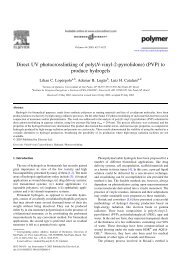
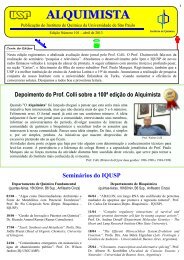
![PE]+ + N. Fragmentação por clivagem sigma](https://img.yumpu.com/50134385/1/180x260/pe-n-fragmentaaao-por-clivagem-sigma.jpg?quality=85)
